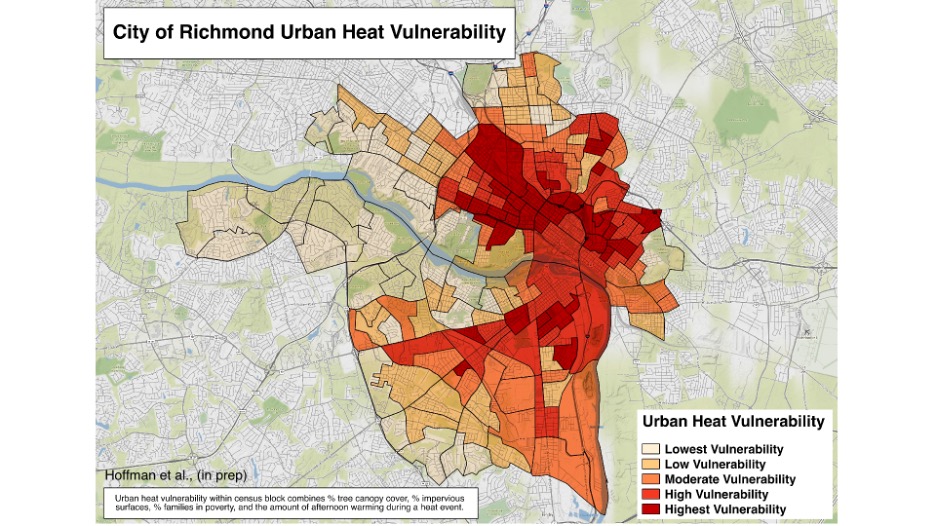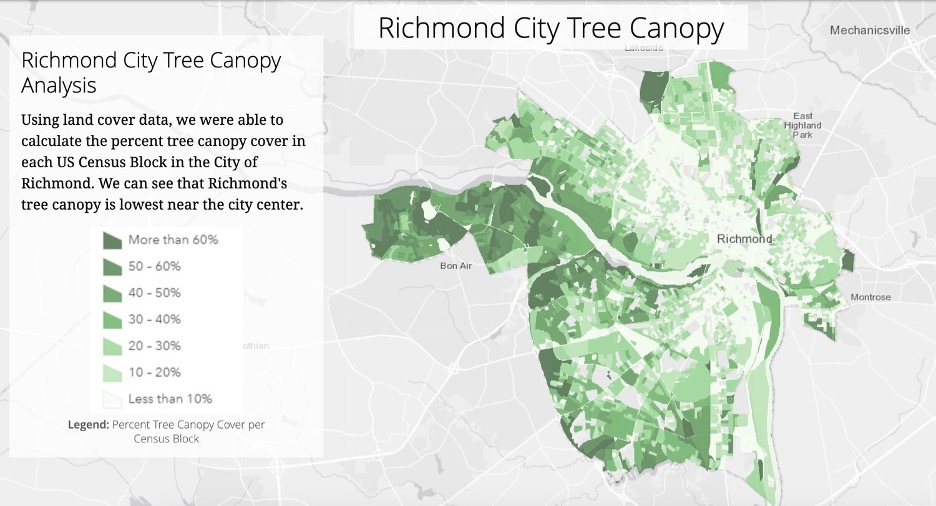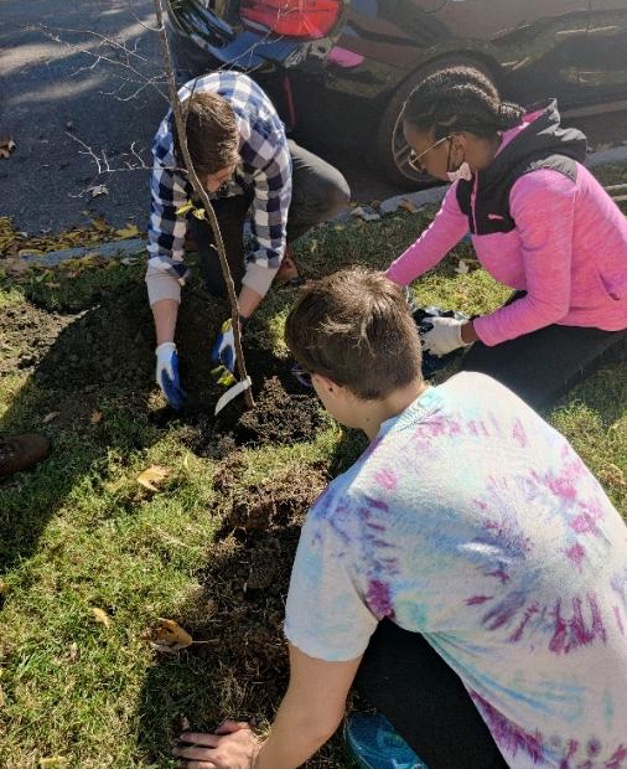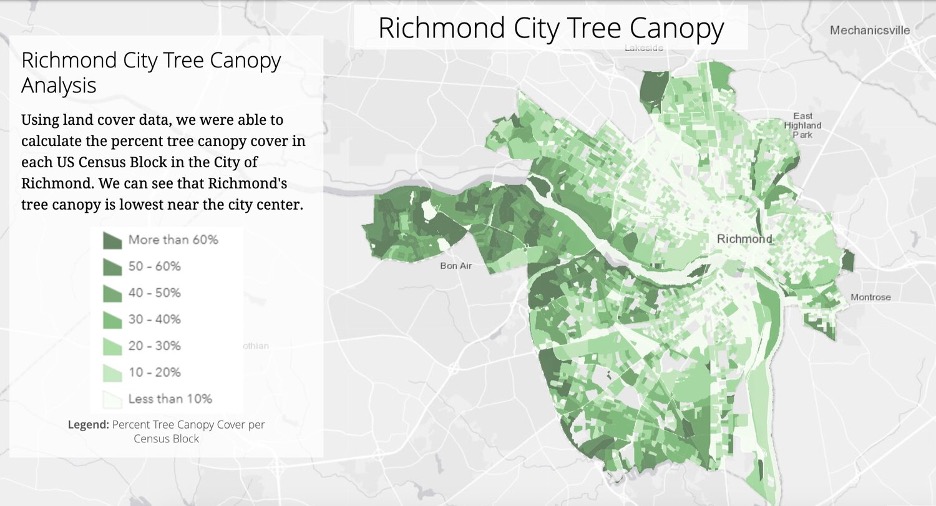Capital Trees’ blog focuses on our developing practices of sustainable management of public landscapes. Ongoing development and care of public landscapes is strengthened by policies supporting greenspace care/development along with consistent funding. In advance of RVArborDay 2022, Capital Trees welcomes guest blogger Daniel Klein, co-founder of ReForest Richmond and vice-chair of the Richmond Green City Commission, to share his opinion on increasing Richmond’s tree canopy. ReForest Richmond is a collaborative campaign to rebuild Richmond’s urban tree canopy. Capital Trees previously discussed the necessity of tree canopy HERE and HERE following the release of the 2020 New York Times article on urban heat island effect.
A Bright Future For Tree Equity in Richmond – by Daniel Klein
After years of disinvestment in our city’s Urban Forestry program, a light is shining through Richmond’s tree canopy. With the Richmond 300 comprehensive plan as a guiding document and a series of hard-fought wins by a coalition of environmental and climate organizations, Richmond’s citizens and tree advocates have a number of reasons to feel optimistic.
Over the past year, our city has achieved the following milestones:
- Adopted a Climate Emergency Resolution highlighting 3 tree priorities
- Funded Richmond’s first Urban Forester position
- Begun the process of creating an Urban Forest Master plan
- Begun steps to reinstitute the Urban Forestry Commission
How do these achievements fit together and why does this matter? First, it is important to acknowledge that Richmond bore witness to and was complicit in some of America’s darkest histories serving as a host city to the Atlantic slave trade, the Capital of the Confederacy, the
Jim Crow South, and recent protests for police accountability. Every day that we exist in this city, we can feel the weight of this history as it continues to play out. Richmond’s track record with equity and justice is abysmal.
But in a time where good news seems rare, we do have reasons for hope. As described in the 2020 NY Times article, we know conclusively that Redlining, a racist Post-War housing policy, is directly tied to increased impervious surfaces (wide roads, parking lots, hard surfaces), hotter than average temperatures, and increased flooding. Racism and white supremacy is baked into the literal pavement of our city and the unequal and unjust distribution of trees, parks, and greenspaces throughout our communities.

We also know that trees, when given adequate growing conditions, can restore canopy in denuded neighborhoods. Tree canopy cools down entire city blocks while slowing down heavy rains and preventing serious flooding. Thus we have on our hands two problems, climate change and a racist built environment, and one solution, trees. It’s of course more complicated than that, but not by much.
Richmond’s comprehensive 20-year plan, Richmond 300 lays out a simple task: increase our city’s tree canopy to a minimum of 30% and with these recent legislative and budgetary wins, we’re now at a critical moment for Richmond’s urban forest. If this momentum continues, our first ever Urban Forester will collaborate with a newly empowered Urban Forestry Commission to contribute to our first Urban Forest Master Plan.
An Urban Forester is desperately needed to ensure we’re all thinking of our city as not simply a distribution of street trees and parks but as an entire forest ecosystem with needs that vary by district, neighborhood, and community. This person would advocate within the city and the community to better protect existing canopy, ensure that new trees are going into high-priority neighborhoods, and revamp our planting and maintenance practices.

The Urban Forestry Collaborative: A community-engaged research project in Richmond, Virginia
A community-driven Urban Forest Master Plan would go a long way towards aligning Richmond’s city divisions and departments, non-profit organizations, and community groups towards a shared vision for achieving our canopy goals with tree equity as its central theme.
We’re not out of the woods yet, but these recent achievements are the closest to a better functioning Urban Forestry program that Richmond has seen in well over a decade.
If you’re looking for ways to get involved and help restore our tree canopy, join Reforest Richmond, Capital Trees, the Richmond Urban Forestry Division, Richmond Community ToolBank, and many other community partners to celebrate our 3rd annual ArborDayRVA.
Check out our lineup and map of free city-wide tree events including tree giveaways, volunteer plantings, workshops, and tours. ArborDayRVA is focused on community empowerment, environmental justice, and climate action. This means that we prioritize formerly redlined and flood-prone communities to direct the benefits of trees to the neighborhoods where they can do the most good now.

Street tree planting in Jackson Ward from ArborDayRVA 2021
Links:
https://www.nytimes.com/interactive/2020/08/24/climate/racism-redlining-cities-global-warming.html
https://pubmed.ncbi.nlm.nih.gov/26828167/
https://nph.onlinelibrary.wiley.com/doi/full/10.1002/ppp3.39


